One of the key challenges in search and content marketing is understanding the intent of our audiences at different stages of the customer journey. The intentions of our audiences as they seek out content, services and products plays a significant role in their behaviours and interactions with our brands, making understanding that intent such an important part of enhancing the experience that we deliver.
The context, location, device and a user’s previous behaviours can all influence the type of result that a user may receive – or want to receive – for what may, on the face of it, seem a relatively straightforward search query. Is somebody searching for “Cowboys” interested in American football or the wild west? Is somebody looking up “JFK” interested the President, or the airport named in his honour?
If we were to think about a query for the term “London Kings’ Cross Station”, we could feasibly see many different intents behind that search depending on the circumstances surrounding that search.
- Somebody on a mobile device in central London may be looking to find out when the next train departs, or whether the Piccadilly Line or the Victoria Line may be a quicker way to get there.
- Somebody on a desktop may perhaps looking for more general information about the station.
- Somebody with a history of Harry Potter-related searches may be more interested in Platform 9¾.
- If the station was the subject of a breaking news story (perhaps some significant disruption), searches for the term may have an intent of finding out more about what had happened.
Whilst these are relatively simple examples of how user intent can influence what a user expects to experience, it does demonstrate just how important intent is and, when it comes to commercial searches, just how we need to be mindful of the content that we provide and the channels that we use across all those different intents.
What triggers a user search journey?
Different journeys will be triggered by different intents and needs, and this is a significant influence on the types of content that we will seek to produce. According to Google, there are six “need states” that influence search behaviour and form the basis of user intent:
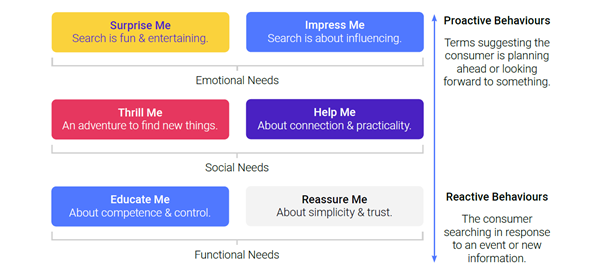
Clearly, the nature of the content that consumers are looking for and expecting for more inspiration-driven terms, such as the ‘surprise me’ and ‘impress me’ stages, is likely to be very different to the more functional search terms, where the consumer is looking for more considered, trustworthy and reassuring content.
However, all these six needs have commercial value and, depending on the nature of our brands, we may lean on certain intents more than others, but it is important to find the right balance. We may be a travel brand that leans heavily on inspirational destination content, but consumers will still need education and reassurance about their chosen holiday and resort – particularly in the current climate when consumers are likely to have anxieties about travel restrictions, health and safety procedures in resorts and airports, and COVID testing policies.
At the other end of the spectrum, we might see financial services as a mostly functional product, usually driven by comparison sites, APRs and eligibility criteria, but can we inspire audiences to finance that big purchase or to save for a rainy day? Can we show them a more exciting side to the product, and what it facilitates?
In trying to do that, it helps to understand what actually causes the search in the first place.
The moments that trigger a search
Whilst we can understand those needs and intents, it is important to also consider what caused those needs in the first place – what Google refers to as “micro-moments”. These are the moments that give birth to a search journey.
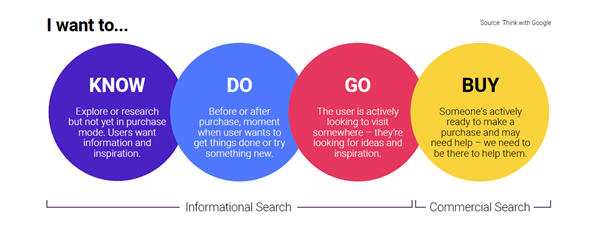
In these moments, searches fall into one of four categories:
- They want to know something, usually when they are exploring or researching options, looking for information and inspiration, but are not yet in purchasing mindset.
- They want to do something, because they want to complete a task or try something new. This could be before or after purchase.
- They want to go This is usually related to searches around travel and leisure, but could also refer to visiting a local business.
- They want to buy something, have committed to a purchasing decision, but may need help in deciding what to buy and how to buy it.
These stages are important because they reflect the state of mind of the searcher as they make that search. Someone may be looking for inspiration, but is that because they are genuinely looking to book a ‘once in a lifetime’ holiday, or is it just a moment of escapism? Is somebody searching for informative content about mortgages doing so because they are ready to buy their first home, or are they in the very early stages of that process? These micro moments help us to understand that so that we can create content that covers the full spectrum of customer needs and intents.
Building the content that reflects these intentions.
When we consider what the trigger points for a search journey are, and the needs of those particular searches, we can start to understand the types of searches that will be made, and the content that is needed to serve them.
Let’s consider, as an example, the intents and needs of expectant parents, and the types of search journeys that they are going to embark on. This is an audience that is clearly going to have various functional needs, social needs and emotional needs, and those needs will be serviced both through purchases (commercial searches) and information. What we need to do is understand which ones will be a mostly informational intent, so that we can ultimately guide them through their journey, as well as which ones will be a mostly purchasing intent, so that we can help them make the right choice.
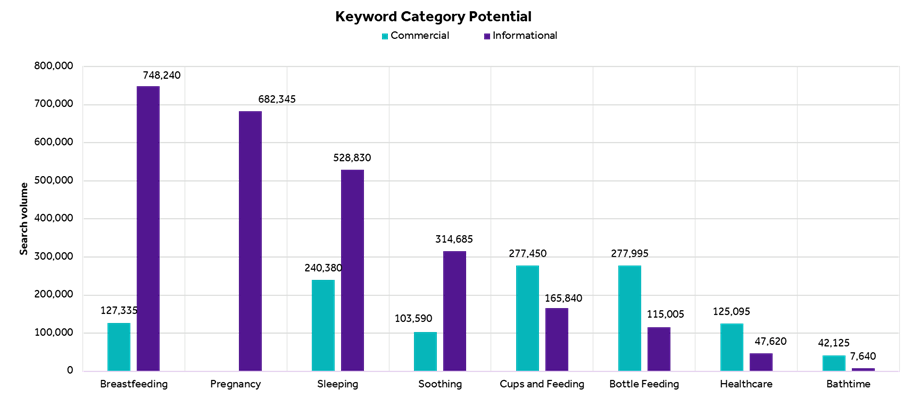
In this case for instance, we can see that topic such as breastfeeding, sleeping and pregnancy will significantly over-index for informational search terms. In other words, informational search terms, such as “how to”, or “best way to”-appended terms, have much greater search volume than product-related terms. The opposite is true for terms relating to cup and bottle feeding, healthcare and bathing.
But even where the opportunity appears to be mostly informational, we can still find commercial value. This is where we can position our brands as trusted authorities in our niche, not only building brand salience in the mind of the consumer, but by addressing those key consumer anxieties that cause friction in the customer journey, and by building online authority that serves us well in ranking for those core commercial terms.
But establishing the keyword opportunities and building our content to suit is certainly not a one-time task. We need to constantly evolve to changing trends
Keyword research to keeping ahead of the curve.
Whilst many of the markets that we operate in are well-established and have a degree of predictability around them, consumer trends, technologies, the competitive landscape and products do change. This means that the world of search is constantly evolving, putting pressure on us to adapt and find better ways to tackle new and existing challenges.
As we highlighted earlier, the contexts and the semantics around keywords can change – often with relatively little notice. One keyword can mean many different things and serve many different intends and equally, many different keywords can serve one general meaning and one general intent.
In this example, two different keywords trigger very similar SERPs, with five shared results.
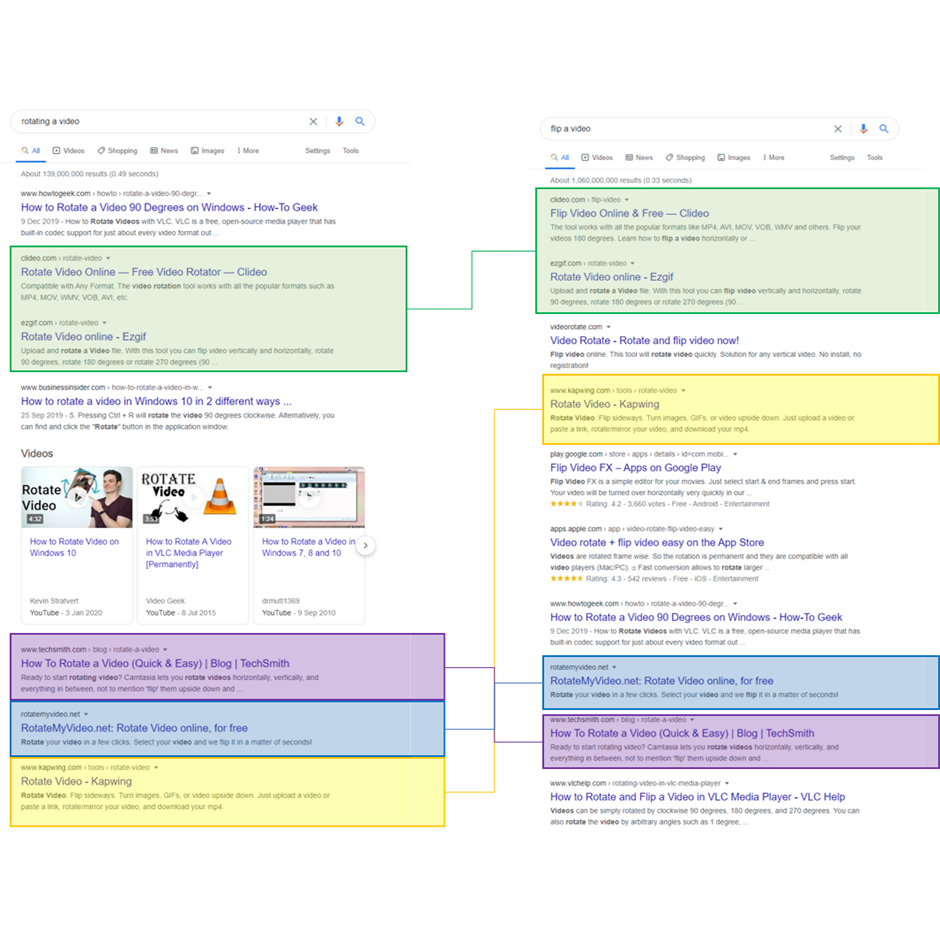
Google’s algorithm considers these two search terms to be semantically related – sharing a similar user intent. As a result, we can optimise a page to rank for both terms and this makes our content much more efficient. The challenge is that identifying these variations of different terms at scale is a large undertaking, and this is where semantic clustering can help.
To support us, Stickyeyes uses an in-house tool called Halcyon, which analyses the search engine results pages to group keywords into semantic clusters based on the similarity of the search results they generate.
This process of semantic clustering helps us to group similar keywords together for better categorisation, to understand what terms should (and shouldn’t) be targeted by the same content and it helps to inform us on the types of content that we should be creating, as the nature of the terms being clustered together provides us with a clearer view of what information Google believes the searcher is looking for.
That helps us to ensure that our keyword strategy stays ahead of the curve and that we can continue creating content that serves the respective intents and needs of the audiences we want to reach.
Intent goes hand in hand with experience
It’s difficult to talk about improving the experience that we provide to our audiences without seriously considering the nature of the intent that goes into those searches, and what the user is expecting to find as a result. People looking for information don’t want to be given the hard, aggressive sell. Those looking to complete their purchase want to be able to do so as easily and as quickly as possible.
Our job is to understand the nuances and the many different ways that a search can be interpreted, and to ensure that the content we create is able to respond to those audience wants and needs.
By understanding those different needs, the triggers that create a search journey and by keeping ahead of the curve on changes to the terms that our audiences use, we can create much more effective search experiences.
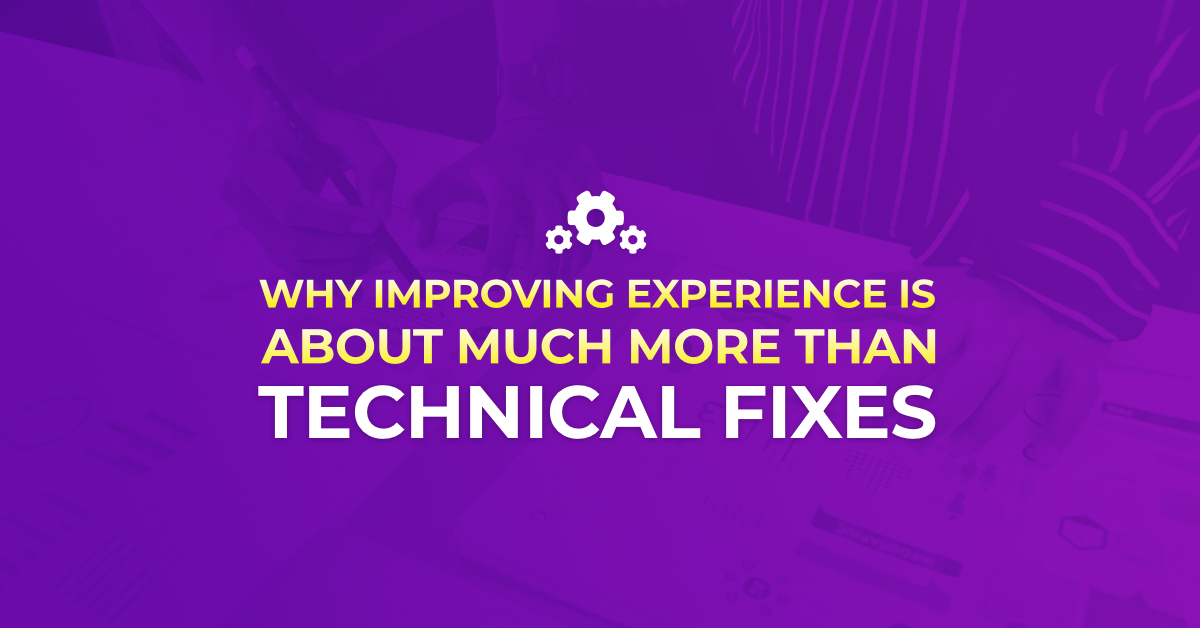
The Google Search Experience Update, rolling out across the summer of 2021, is the latest in a long line of updates from the search engine to encourage a better, safer, faster and more secure online experience.
In this whitepaper we explain how to put user experience at the heart of your search marketing strategy. In identifying the causes of friction that frustrate the customer journey we can make our performance marketing much more effective, making better use of content, media and organic and paid search to deliver greater ROI. Want to find out more?
In this 36 page guide we will cover:
A closer look at the Google Search Experience update.
What it is, how it affects your search marketing strategy and how you need to respond.
Why experience matters.
Why user experience is at the top of the agenda for Google, and why it should be the focus of your performance marketing strategy.
How we can improve flow through the customer journey.
Identifying the pain points and causes of friction in the customer journey, to help our audiences do what they want to do.
Delivering content that enhances the experience.
How we can identify what our audiences want at each stage of the journey.
Improving the performance of search marketing.
How to make sure that organic search and paid media is working in perfect harmony to target the right audiences as efficiently as possible,
